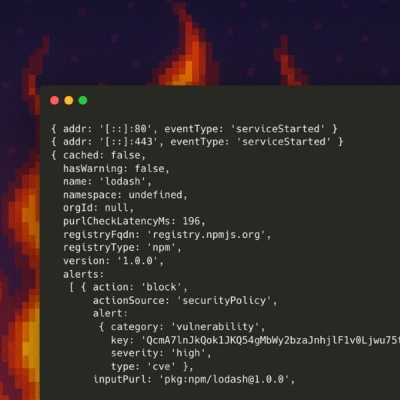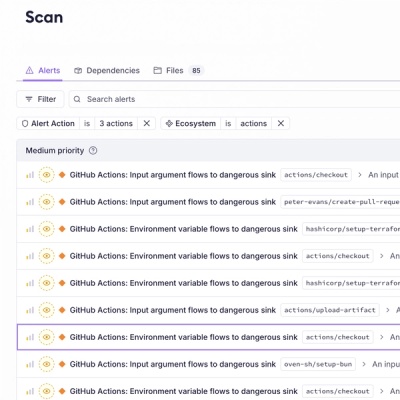
Product
Introducing Socket Firewall Enterprise: Flexible, Configurable Protection for Modern Package Ecosystems
Socket Firewall Enterprise is now available with flexible deployment, configurable policies, and expanded language support.
asset_builder
Advanced tools
Simple middleware for compiling, concatenating, minifying, and caching assets with Express.
npm install asset_builder
or add it ot your package.json file:
{
"dependencies": {
"asset_builder": "0.2"
},
}
Basic example:
app.js
var express = require("express");
assetbuilder = require("asset_builder");
var app = express.createServer();
app.use(assetbuilder.middleware);
app.use(express.static(path.join(__dirname, "public")));
app.listen(8000);
app/assets/application.js.json
{
"files": [
"javascripts/lib/boot.js",
"javascripts/lib",
"javascripts/"
]
}
Link to assets in the view using the provided stylesheetUrl and javascriptUrl helpers, and it will concatenate (in order):
Serve stylesheets too (css or less):
app/assets/application.css.json
{
"files": [
"stylesheets/normalize.css",
"stylesheets/base.less",
"stylesheets/"
]
}
var express = require("express");
assetbuilder = require("asset_builder");
var app = express.createServer();
app.use(assetbuilder.middleware);
Configuration is only necessary to override the default settings. Below is an example showing the default settings:
assetbuilder.configure({
src_root: path.join("app", "assets"),
dst_root: path.join("public", "assets"),
base_url: "/assets",
env: "production"
});
View helpers can be registered with express with the following call:
assetbuilder.registerViewHelpers(app);
The views now have access to two url helpers: stylesheetUrl and javscriptUrl
An example layout.jade file looks like this:
!!! 5
html
head
link(rel="stylesheet", type="text/css", href=stylesheetUrl)
script(type="text/javascript", src=javascriptUrl)
In order to serve javascript and css assets, static file middleware needs to be registered after the asset builder.
app.use(assetbuilder.middleware);
app.use(express.static(path.join(__dirname, "public")));
Asset Builder looks for a json file describing the content of the asset to be built. By default, it looks for app/assets/application.js.json and app/assets/application.css.json
Example: application.js.json
{
"files": [
"javascripts/lib/boot.js",
"javascripts/lib",
"javascripts/"
]
}
Paths are relative to the json file. IE: The above looks for app/assets/javascripts/lib/boot.js
Here is an example of a typical express middleware stack:
var express = require("express");
var assetbuilder = require("asset_builder");
var router = require("./app/router");
var app = express.createServer();
app.configure(function() {
this.use(express.errorHandler({
showStack: true,
dumpExceptions: true
}));
this.use(assetbuilder.middleware);
this.use(express.static(path.join(__dirname, "public")));
this.use(express.bodyParser());
this.use(express.methodOverride());
this.use(express.cookieParser());
this.use(express.session({ secret: "keyboard cat" }));
this.use(express.router(router));
this.set("views", path.join(__dirname, "app", "views"));
this.set("view engine", "jade");
this.set("view options", {layout: false });
});
assetbuilder.registerViewHelpers(server);
assetbuilder.configure({
src_root: path.join(__dirname, "app", "assets"),
dst_root: path.join(__dirname, "public", "assets"),
base_url: "/assets",
env: "production"
});
server.listen(8000);
Don't like the default paths, or url's? No problem.
The options shown below are the defaults:
var assetbuilder = require("asset_builder");
assetbuilder.configure({
src_root: path.join(__dirname, "app", "assets"),
dst_root: path.join(__dirname, "public", "assets"),
base_url: "/assets",
env: "development"
});
This is the directory where Asset Builder will look for application.js.json and application.css.json. Filenames within the json manifest files are resolved relative to this root.
This is the directory where Asset Builder will write the generated asset files (application.js and application.css). Note that the static file server must be able to serve files from this directory.
This is the leading portion of the url that will be used by both Asset Builder and the static file server.
Ex: /assets/application.js
Note that this setting is tied to the dst_root setting.
Files written to dst_root need to be served by the static file server with a request to base_url.
The environment Asset Builder is running in.
Defaults to "development", which performs no caching. When set to "production", caching is enabled.
The asset manifest is a json file named either application.js.json or application.css.json. By default, they are located in the app/assets directory, see the options section to change their location. The manifest files contain an array of filenames and directory names that will be used to build the asset.
Files are included in the order they are specified in the manifest. Directories will recursively include all matching files (js or hbs for javascripts, css or less for stylesheets)
No file will be included twice, even if it matches multiple file or directory listings.
If certain files need to be included before others, specify those files first, ex:
{
"files": [
"javascripts/lib/boot.js",
"javascripts/lib",
"javascripts/"
]
}
Asset Builder can only serve two types of assets: javascript and css. However, Asset Builder uses preprocessors to convert an input file into one of these types.
Two preprocessors are included (handlebars and less), and custom preprocessors can be registered dynamically.
Handlebar templates will be precompiled by Asset Builder if their path is included in the javascript manifest, and they have a .hbs file extension.
Precompiled templates will be available (in the browser) in a global hash called Handlebars.templates, with the filename as the key.
For example, a template named foo.hbs, would be stored at Handlebars.templates.foo
Example template:
<h1>{{title}}</h1>
For details, see the handlebars website
Less stylesheets will be compiled into css by Asset builder if their path is included in the stylesheet manifest, and they have a .less file extension.
Custom preprocessors can be registered dynamically using the registerPreprocessor function.
An example of a javascript preprocessor that append a comment onto each file with the .foo extension:
var myPreprocessor = {
ext: "foo",
preprocessor: function(data, filepath, hollaback) {
var error = null;
var content = data + "// Comment!";
hollaback(error, content);
}
};
assetbuilder.registerPreprocessor(myPreprocessor);
See the wiki for more complicated examples, including Ember support.
There are two kinds of caching performed:
Assets that are built can be cached.
When an asset request is processed, response headers are set to maximize the chance of client caching.
Each browser uses a set of heuristics to determine if files should be downloaded, or served from cache. Asset builder follows Google's optimize caching recommendations to maximize the chance of client caching.
There are three possible client actions:
If-Modified-Since request, and either downloads the asset or uses the cached version depending on response.Clearly, option 3 is most desirable. In order to maximize the chances of full caching, Asset Builder sets the following headers:
Expires header to be one year from nowLast-Modified header to be one month agoCache-Control header to public to enable caching of assets served over sslExample asset response: (Made on January 22, 2012)
HTTP/1.1 200 OK
X-Powered-By: Express
Expires: Mon, 21 Jan 2013 14:50:31 GMT
Cache-Control: public
Last-Modified: Fri, 23 Dec 2011 04:50:31 GMT
Date: Sun, 22 Jan 2012 14:50:31 GMT
ETag: "286234-1327243831000"
Content-Type: application/javascript
Accept-Ranges: bytes
Content-Length: 286234
Connection: keep-alive
You might be wondering: If the client unconditionally caches the file, how do I prevent stale assets from being used on the client?
Asset Builder's link helpers generate unique links for the assets.
For example: assets/application_b1010839e0914dc8cbbfd8d4aecf9a161db917be81a4f7c3317f141dcae700fe.js
When the file name of the asset changes, the client sees it as a new file and will no longer use any previously cached versions.
In development mode, the links generated by the link helpers are unique on each request.
In production mode, the links generated by the link helpers include a SHA256 hash of the asset, so they will only change when the asset changes.
An additional step to maximize performance is to compress (gzip) the contents of the assets.
This can be enabled several ways:
See the Options section on base_url and dst_root to serve assets separately from other static files.
In development mode, assets are generated for each request. Additionally, the link helpers generate unique links for each request.
In production mode, assets are only built once, and served from cache thereafter. The link helpers generate links based on the SHA256 hash of the asset content, so the links will only change when the content of the assets change.
MIT, see the LICENSE file.
FAQs
build, concatenate, and compress assets
We found that asset_builder demonstrated a not healthy version release cadence and project activity because the last version was released a year ago. It has 1 open source maintainer collaborating on the project.
Did you know?

Socket for GitHub automatically highlights issues in each pull request and monitors the health of all your open source dependencies. Discover the contents of your packages and block harmful activity before you install or update your dependencies.

Product
Socket Firewall Enterprise is now available with flexible deployment, configurable policies, and expanded language support.

Security News
Open source dashboard CNAPulse tracks CVE Numbering Authorities’ publishing activity, highlighting trends and transparency across the CVE ecosystem.

Product
Detect malware, unsafe data flows, and license issues in GitHub Actions with Socket’s new workflow scanning support.